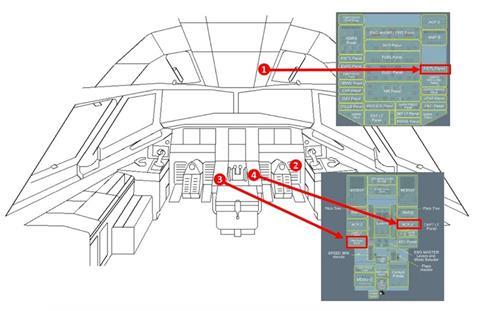Spanish investigators have disclosed that the first officer of a Lufthansa Airbus A321 suffered a serious seizure while alone in the cockpit for 10min, during which he inadvertently operated switches and made flight-control inputs.
The incident occurred in cruise at 35,000ft between the GARVU and BANEV waypoints in northern Spain as the twinjet (D-AISO) was flying from Frankfurt to Seville on 17 February last year.
Spanish investigation authority CIAIAC says the first officer experienced “sudden and severe incapacitation” just 36s after the captain had left the cockpit for the lavatory.
The inquiry found the first officer had a neurological condition – undetected either by himself or during previous aeronautical medical examinations – which would have disqualified a pilot from obtaining medical fitness to fly.
CIAIAC says the captain had briefly discussed weather conditions with the first officer before leaving the flightdeck. The first officer appeared “able and alert” and the captain had not noticed anything unusual in his behaviour.
But shortly after being left alone, the first officer – who was 38 years of age and held a valid Class 1 medical certificate without limitations – suffered a loss of consciousness so sudden that he was unable to warn others of the situation.
Over the first 46s from the seizure’s onset, one of the spoiler elevator computers was disconnected, de-activating four inboard spoilers, a pair either side, and triggering warnings. The operating mode of the weather radar changed, and an audio control panel switch was activated.
There was also a sudden increase of force on the right rudder pedal to 488N, sufficient to generate a ‘stop rudder input’ warning – although remaining short of the threshold to disengage the autopilot. The pedal input resulted in a 5° roll and 2° heading change, for which the autopilot compensated.
The aircraft passed the BANEV waypoint and, as it approached the boundary of the PAU and TLU en route sectors, air traffic control attempted three times to contact the crew for the handover.
When the captain attempted to return to the cockpit, the first officer initially did not respond to his request for re-entry, and could not be reached by the cabin crew.
After spending nearly 2min 30s trying the entry-code procedure, up to five times, the captain reverted to an emergency code. This involves waiting for a fixed time delay, but the first officer unlocked the door before it expired.
The captain re-entered the cockpit, 10min after the first officer’s seizure, taking control of the aircraft and re-establishing communication with air traffic control.

“As the [first officer] was pale, sweating and moving strangely, the captain called for assistance from the cabin crew,” says the inquiry. First aid was rendered by the crew and a doctor, who diagnosed a possible heart condition, and the captain initiated a diversion to Madrid Barajas airport. The A321 landed 20min later. None of the 205 occupants was injured.
The first officer had no recollection from the period of incapacitation. “He remembered flying over Zaragoza and, the next thing, he was being attended to by the cabin crew and a doctor,” the inquiry states.
As a precautionary measure, the first officer’s medical certificate was suspended. According to the Spanish national safety agency AESA, his illness would have been detectable during a medical examination only if symptoms had been present at the time, or manifested themselves beforehand.
Following the fatal March 2015 crash of an A320 operated by Germanwings – a subsidiary of Lufthansa Group – carriers had been instructed to assess security risks associated with a single pilot being left alone in the cockpit.
While Lufthansa had initially responded by requiring two authorised persons in the cockpit at all times – with a cabin crew member temporarily substituting for an absent pilot – the airline subsequently modified the procedure after determining that it did not increase the safety of its operation. At the time of the A321 occurrence, it no longer required the continual presence of two people in the cockpit.
CIAIAC is recommending that the European Union Aviation Safety Agency informs carriers of the incident to help with their risk analyses.
“We consider it appropriate to convey the particularities of this incapacitation to operators so that they can take it into account and reassess the risks associated with a pilot remaining alone on the flightdeck,” it states.




